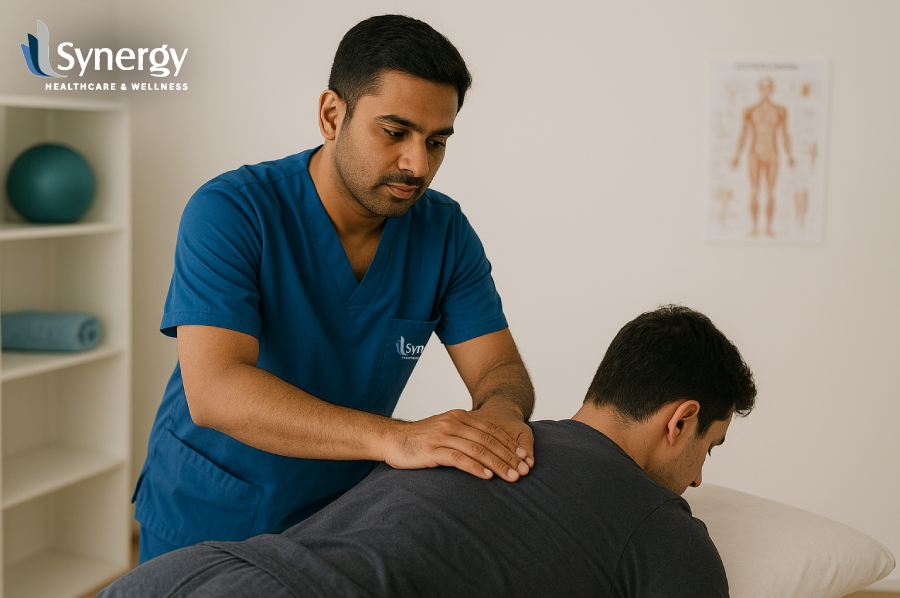One of the first things most people want to know is, “How long does physiotherapy take to work?” It’s a fair question, but there isn’t a single answer that fits everyone. The pace of recovery depends on several factors; some within your control, and others built into the body’s natural healing process. Still, there are patterns and timelines that can help you set realistic expectations.
Why It’s Hard to Give a Simple Answer
Everybody heals differently. Some of the main factors that affect how quickly you notice results include:
- The type and severity of your condition. A mild muscle strain won’t take as long to improve as a torn ligament or a complex surgical recovery.
- Which tissue is injured. Muscles, tendons, ligaments, cartilage, and bone each have different healing speeds.
- Your general health and age. Younger, active people often heal faster, while chronic health conditions can slow things down.
- How consistent you are with treatment. Attending sessions regularly and doing your home exercises makes a huge difference.
- When you start therapy. Early treatment usually means faster, more complete recovery.
- The progression of your plan. A tailored, steadily challenging program tends to bring results sooner than a routine that stays the same week after week.
Because of all these variables, most physiotherapists prefer to talk in ranges rather than fixed numbers of weeks.
Early Signs: What You Might Notice First
Many people begin to see small but encouraging changes within the first few sessions. You might notice:
- A little less pain or fewer flare-ups
- More effortless movement or less stiffness
- More confidence in using the affected area
- Reduced tension or guarding in nearby muscles
- Better sleep because of less soreness
These early gains can seem minor, but they’re important—they show your body is responding and healing has begun.
Typical Recovery Timelines [How Long Does Physiotherapy Take]
Here’s a general idea of how long different tissues take to heal when you’re doing regular physiotherapy and following guidance at home:
| Type of Injury | Typical Healing Time | Notes |
| Muscle strain | 2–4 weeks | Muscles have good blood flow, so they repair fairly quickly. |
| Tendon injury | 4–6 weeks | Slower healing because of lower blood supply. |
| Bone fracture | 6–8 weeks | Therapy usually starts once the bone is stable. |
| Ligament or cartilage injury | 10–12 weeks or more | These tissues heal slowly and may need more support. |
| Post-surgical rehabilitation | 3–6 months or longer | Depends on the type of surgery and overall condition. |
| Chronic or degenerative issues | Several weeks to months | Managed progressively to improve function and reduce pain. |
Healing is rarely a straight line. Some weeks bring visible progress; others feel slower. That’s normal.
How Many Sessions Until You Notice Results?
In most cases, noticeable progress appears between five and twelve sessions, especially when therapy is consistent and the program is gradually intensified. That doesn’t mean you’ll be completely recovered in that time, but you’ll likely start feeling stronger, looser, and more capable.
If you’ve been diligent and still feel no change after several weeks, it’s worth discussing this with your physiotherapist. Sometimes, a small adjustment to your plan can restart progress.
The Stages of Physiotherapy
It helps to think of therapy as a series of overlapping stages rather than a straight path:
- Pain and Protection Phase – The focus is on calming pain and inflammation while protecting healing tissue. (Days to a few weeks.)
- Mobility and Flexibility Phase – As pain eases, exercises start to restore movement and basic strength. (Weeks 2–6.)
- Strength and Conditioning Phase – Work becomes more challenging, building endurance, stability, and balance. (Weeks 4–12 and beyond.)
- Return to Function Phase – The aim is to get you back to work, sport, or daily tasks safely. (Often takes several months.)
- Maintenance Phase – Once you’ve reached your goals, occasional check-ins and home routines help prevent setbacks.
Your physiotherapist will adjust your program at each stage, depending on how your body responds.
Why Some People Take Longer
Recovery doesn’t always move at the same speed for everyone. Some common reasons for slower progress include:
- Missing appointments or skipping home exercises
- Other health conditions, like diabetes or circulation issues
- Poor sleep, nutrition, or stress
- Scar tissue or stiffness that limits motion
- Starting therapy late after the injury
- Emotional barriers, such as fear of movement
If you feel stuck, don’t get discouraged. Talk to your therapist—they can reassess, change techniques, or refer you for further evaluation if needed.
How to Help Your Body Heal Faster
You can play an active role in your recovery. Here are practical ways to support the process:
- Keep up with your appointments. Consistency builds momentum.
- Do your home exercises. They bridge the gap between sessions.
- Speak up about changes. Tell your therapist what feels better or worse.
- Follow progressive loading. Gradual challenge helps tissues strengthen safely.
- Look after your overall health. Eat well, stay hydrated, rest properly, and manage stress.
- Watch your posture and habits. Avoid putting repeated strain on healing areas.
- Be patient and persistent. Small, steady progress adds up over time.
When to Expect Noticeable Change
Most people start to feel some improvement between two and four weeks of consistent therapy. Pain may ease, stiffness may lessen, or strength may begin to return. Remember, “feeling better” doesn’t mean you’re finished—it means you’re on the right track.
If you’ve been attending sessions for a few weeks without any improvement, bring it up. A simple reassessment or modification in exercises can often reignite progress.
Synergy Physiotherapy – Helping You Move Better, Live Better
At Synergy, we believe recovery starts with understanding. Our team works closely with you to find the cause of pain, restore balance, and build lasting strength. Every treatment plan is personal and guided by experience, not routine. We focus on progress you can feel—in the way you move, work, and live. Whether you’re healing from an injury or improving everyday mobility, we’re here to help you get back to your routine.
Key Takeaways
- Physiotherapy results depend on the injury type, health factors, and how committed you are to the plan.
- Early changes can appear within a few sessions.
- Noticeable improvement often comes between the fifth and twelfth sessions.
- Recovery timelines range from a few weeks for mild injuries to several months for complex cases.
- Consistency, communication, and effort play a central role in how quickly you improve.
FAQs
1. How soon will I start feeling better after physiotherapy?
Many people notice small changes—less pain or better movement—within the first few sessions. Most experience clear progress between the fifth and twelfth session, depending on the condition and consistency of treatment.
2. How often should I attend physiotherapy sessions?
Most recovery plans begin with two to three sessions per week. As you improve, your therapist may reduce frequency and focus more on home exercises and independent strength work.
3. What happens if I miss sessions?
Skipping appointments can slow your progress and disrupt your body’s adaptation to treatment. Staying consistent helps results build over time.
4. Can I do my regular workouts during physiotherapy?
It depends on your injury. In most cases, your physiotherapist will modify your routine to keep you active without aggravating the affected area.
5. Why do some people recover faster than others?
Healing speed depends on injury type, general health, age, and how closely you follow your treatment plan and home exercises.












